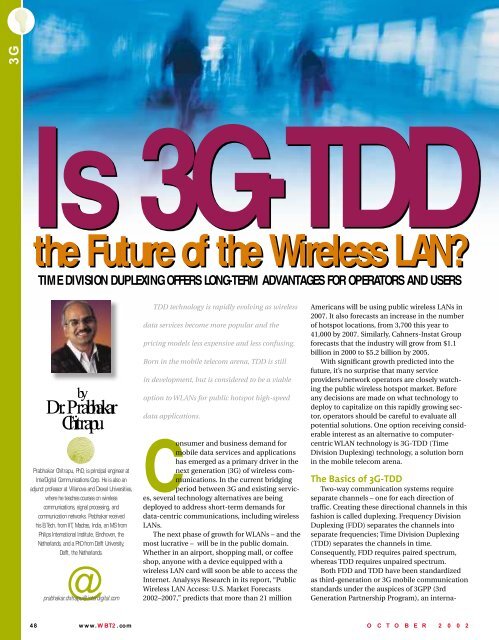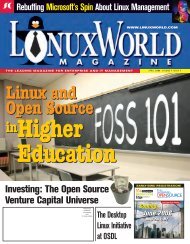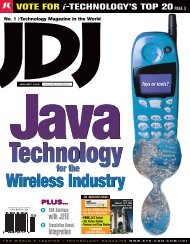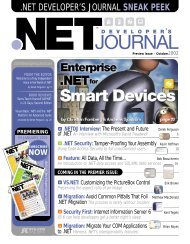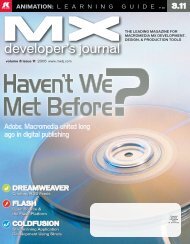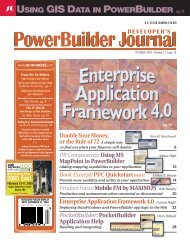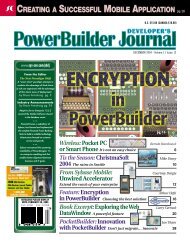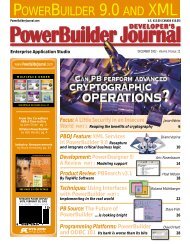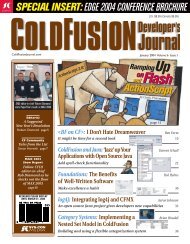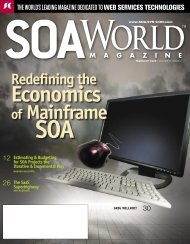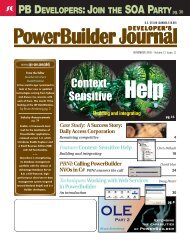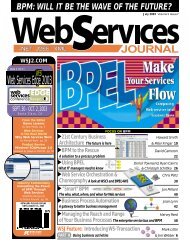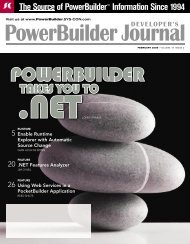wireless in action - sys-con.com's archive of magazines - SYS-CON ...
wireless in action - sys-con.com's archive of magazines - SYS-CON ...
wireless in action - sys-con.com's archive of magazines - SYS-CON ...
- No tags were found...
Create successful ePaper yourself
Turn your PDF publications into a flip-book with our unique Google optimized e-Paper software.
3GIs 3G-TDDthe Future <strong>of</strong> the Wireless LAN?TIME DIVISION DUPLEXING OFFERS LONG-TERM ADVANTAGES FOR OPERATORS AND USERSbyDr. PrabhakarChitrapuPrabhakar Chitrapu, PhD, is pr<strong>in</strong>cipal eng<strong>in</strong>eer atInterDigital Communications Corp. He is also anadjunct pr<strong>of</strong>essor at Villanova and Drexel Universities,where he teaches courses on <strong>wireless</strong>communications, signal process<strong>in</strong>g, andcommunication networks. Prabhakar receivedhis B.Tech. from IIT, Madras, India, an MS fromPhilips International Institute, E<strong>in</strong>dhoven, theNetherlands, and a PhD from Delft University,Delft, the Netherlands.@prabhakar.chitrapu@<strong>in</strong>terdigital.comTDD technology is rapidly evolv<strong>in</strong>g as <strong>wireless</strong>data services become more popular and thepric<strong>in</strong>g models less expensive and less <strong>con</strong>fus<strong>in</strong>g.Born <strong>in</strong> the mobile telecom arena, TDD is still<strong>in</strong> development, but is <strong>con</strong>sidered to be a viableoption to WLANs for public hotspot high-speeddata applications.Consumer and bus<strong>in</strong>ess demand formobile data services and applicationshas emerged as a primary driver <strong>in</strong> thenext generation (3G) <strong>of</strong> <strong>wireless</strong> communications.In the current bridg<strong>in</strong>gperiod between 3G and exist<strong>in</strong>g services,several technology alternatives are be<strong>in</strong>gdeployed to address short-term demands fordata-centric communications, <strong>in</strong>clud<strong>in</strong>g <strong>wireless</strong>LANs.The next phase <strong>of</strong> growth for WLANs – and themost lucrative – will be <strong>in</strong> the public doma<strong>in</strong>.Whether <strong>in</strong> an airport, shopp<strong>in</strong>g mall, or c<strong>of</strong>feeshop, anyone with a device equipped with a<strong>wireless</strong> LAN card will soon be able to access theInternet. Analy<strong>sys</strong> Research <strong>in</strong> its report, “PublicWireless LAN Access: U.S. Market Forecasts2002–2007,” predicts that more than 21 millionAmericans will be us<strong>in</strong>g public <strong>wireless</strong> LANs <strong>in</strong>2007. It also forecasts an <strong>in</strong>crease <strong>in</strong> the number<strong>of</strong> hotspot locations, from 3,700 this year to41,000 by 2007. Similarly, Cahners-Instat Groupforecasts that the <strong>in</strong>dustry will grow from $1.1billion <strong>in</strong> 2000 to $5.2 billion by 2005.With significant growth predicted <strong>in</strong>to thefuture, it’s no surprise that many serviceproviders/network operators are closely watch<strong>in</strong>gthe public <strong>wireless</strong> hotspot market. Beforeany decisions are made on what technology todeploy to capitalize on this rapidly grow<strong>in</strong>g sector,operators should be careful to evaluate allpotential solutions. One option receiv<strong>in</strong>g <strong>con</strong>siderable<strong>in</strong>terest as an alternative to computercentricWLAN technology is 3G-TDD (TimeDivision Duplex<strong>in</strong>g) technology, a solution born<strong>in</strong> the mobile telecom arena.The Basics <strong>of</strong> 3G-TDDTwo-way communication <strong>sys</strong>tems requireseparate channels – one for each direction <strong>of</strong>traffic. Creat<strong>in</strong>g these directional channels <strong>in</strong> thisfashion is called duplex<strong>in</strong>g. Frequency DivisionDuplex<strong>in</strong>g (FDD) separates the channels <strong>in</strong>toseparate frequencies; Time Division Duplex<strong>in</strong>g(TDD) separates the channels <strong>in</strong> time.Consequently, FDD requires paired spectrum,whereas TDD requires unpaired spectrum.Both FDD and TDD have been standardizedas third-generation or 3G mobile communicationstandards under the auspices <strong>of</strong> 3GPP (3rdGeneration Partnership Program), an <strong>in</strong>terna-tional partnership <strong>of</strong> standards development organizations. ManyEuropean and Asian operators have acquired 3G spectrum, which<strong>in</strong>cludes both paired FDD and unpaired TDD bands. Generally, thepaired FDD spectrum is planned for provid<strong>in</strong>g wide area coverageand, <strong>in</strong> most cases, the unpaired TDD spectrum, a revenue-generat<strong>in</strong>gasset, has not yet been leveraged.Compar<strong>in</strong>g WLANs and 3G-TDDSo what characteristics make 3G-TDD a viable alternative toWLANs for public hotspot high-speed data applications? Let’s compareand <strong>con</strong>trast 3G-TDD with WLANs <strong>in</strong> the key areas <strong>of</strong> primary<strong>con</strong>cern to service providers/network operators and end users:SPECTRUMWLANs operate <strong>in</strong> the unlicensed spectrum. As a result, otherproducts that transmit energy <strong>in</strong> the same frequency range – such as aBluetooth-enabled device – can potentially cause some degree <strong>of</strong><strong>in</strong>terference. This <strong>of</strong>ten has a detrimental effect on performance andthe user experience. In <strong>con</strong>trast, 3G-TDD is designed to operate <strong>in</strong> thelicensed spectrum, which is a <strong>con</strong>trolled environment where operatorscan guarantee a certa<strong>in</strong> level <strong>of</strong> service.The downside <strong>of</strong> course is that the availability <strong>of</strong> licensed spectrumis limited. However, as mentioned previously, many providersthat have purchased 3G licenses already possess paired (FDD) andunpaired (TDD) bands.MOBILITYComputer-centric WLANs <strong>of</strong>fer “islands” <strong>of</strong> coverage. Problemscan arise when the user moves from one “island” to another. While<strong>in</strong>dustry bodies are work<strong>in</strong>g to address the hand-<strong>of</strong>f issue betweenthese “islands,” there is currently no standardized solution toenable comprehensive service roam<strong>in</strong>g without any degradation <strong>in</strong>performance.Com<strong>in</strong>g from the mobile telecom environment, 3G-TDD hasbeen designed from the outset to accommodate the needs <strong>of</strong> themobile user through standards-based hand<strong>of</strong>fs and tight synchronizationwith 3G-FDD. The synergistic relationship between thewide coverage area provided by 3G-FDD and the hotspot coverage<strong>of</strong> 3G-TDD provides a key advantage. Due to the seamless hand<strong>of</strong>fsthat are possible between 3G-TDD and 3G-FDD <strong>sys</strong>tems, a userthat leaves a 3G-TDD coverage area and enters a 3G-FDD coveragearea will not experience any <strong>in</strong>terruption <strong>in</strong> service, althoughthroughput will be reduced.NETWORK INTEGRATIONIn the public access arena, network <strong>in</strong>tegration is a fundamentalrequirement. To provide public access to a WLAN, the variousislands <strong>of</strong> coverage have to be tightly <strong>in</strong>tegrated <strong>in</strong>to a back-endnetwork for common authentication, bill<strong>in</strong>g, and other basic functions.Another key driver for <strong>in</strong>tegration is the ability to provideseamless access to “always on” position-based multimedia services.While <strong>in</strong>dustry bodies are currently def<strong>in</strong><strong>in</strong>g an <strong>in</strong>dustry standardfor <strong>in</strong>tegrat<strong>in</strong>g WLANs <strong>in</strong>to the core network, it does not existtoday. In <strong>con</strong>trast, 3G-TDD, due <strong>in</strong> part to its mobile telecom heritage,has been designed from the outset to be tightly <strong>in</strong>tegratedwith a much larger core network. Indeed, this is part <strong>of</strong> the orig<strong>in</strong>al3G-TDD specification. 3G-TDD can be used not only <strong>in</strong> <strong>con</strong>junctionwith 3G-FDD, but also as a standalone technology to provideDSL-like service.MULTIMEDIA CAPABILITIESAs an IP-based, computer-centric solution, WLANs are optimizedfor data services, not real-time services such as voice. Workis progress<strong>in</strong>g to address this by add<strong>in</strong>g a radio resource management<strong>sys</strong>tem. In <strong>con</strong>trast, 3G-TDD has been designed to deliverboth voice and data dynamically. By establish<strong>in</strong>g simultaneous circuit-switchedand packet-switched <strong>con</strong>nections over the air <strong>in</strong>terface,a user could talk and surf the Web at the same time with thesame device.Due to its mobile telephony heritage, 3G-TDD can also provideaccess to a wide range <strong>of</strong> high-revenue (for the service provider)and high-value (for the user) data-<strong>in</strong>tensive services such as multimediamessag<strong>in</strong>g services (MMS), synchronization <strong>of</strong> personal digitalassistants (PDAs), Internet chat, as well as picture, video, andmusic downloads. In addition, 3G-TDD can also provide <strong>con</strong>t<strong>in</strong>uousaccess to location-based services. Deliver<strong>in</strong>g these types <strong>of</strong>services is a much more difficult proposition for IP-based WLANsolutions.SECURITYIt is widely known that the current WLAN technology is far fromsecure – not only for demand<strong>in</strong>g m-commerce applications, butalso for simple privacy <strong>of</strong> user data. In fact the common practicetoday is to disable the <strong>in</strong>built WLAN security feature and relyentirely on application-level methods to ensure security. Whilestandardizations are currently under way to fix and improve WLANsecurity, <strong>in</strong>dustry acceptance and product availability will takemore time. 3G-TDD provides a high level <strong>of</strong> security to users aswell as network operators with proven techniques that have beenused <strong>in</strong> GSM <strong>sys</strong>tems all over the world.POWER <strong>CON</strong>SUMPTIONThe power requirements for WLAN devices are high per <strong>in</strong>dividualdevice, <strong>of</strong>ten reach<strong>in</strong>g 100 milliwatts. This can be attributed totheir roots <strong>in</strong> a corporate computer-based environment wherepower restrictions were not an issue. Because 3G-TDD wasdesigned to be deployed <strong>in</strong> mobile handheld devices, great carewas taken to optimize power <strong>con</strong>sumption. To reduce power <strong>con</strong>sumption,3G-TDD devices can leverage “idle mode” or “sleepmode.” Currently, WLAN PCMCIA cards do not <strong>of</strong>fer this option <strong>in</strong>an optimal standardized way.SCALABILITYAs a <strong>con</strong>sequence <strong>of</strong> their limited mobility, WLANs are not particularlyscalable. As more and more cells are added, hand<strong>of</strong>fsbecome an issue. And as more and more users are added, performance(throughput) is compromised. By comparison, 3G-TDD isvery scalable and delivers <strong>con</strong>sistent performance over a widerange <strong>of</strong> coverage scenarios: <strong>in</strong> build<strong>in</strong>g (pico cell), urban (microcell), and suburban (macro cell, when used <strong>in</strong> <strong>con</strong>junction with3G-FDD) sett<strong>in</strong>gs.QUALITY OF SERVICE (QoS)QoS is determ<strong>in</strong>ed by the <strong>con</strong>sistency <strong>of</strong> the user experienceand throughput. The user experience with WLANs can bedescribed as unpredictable, especially when an <strong>in</strong>dividual moves<strong>in</strong> and out <strong>of</strong> coverage areas. In do<strong>in</strong>g so, the user will see a significantshift <strong>in</strong> service quality and throughput, depend<strong>in</strong>g on the distancefrom the access po<strong>in</strong>t. As a result, it is virtually impossiblefor service operators to provide QoS guarantees.Because <strong>of</strong> the <strong>in</strong>herent power <strong>con</strong>trol <strong>of</strong> 3G-TDD and <strong>in</strong>telligencethat will be built <strong>in</strong>to 3G-TDD devices, performance andthe user experience will not vary. As part <strong>of</strong> its standard, 3G-TDD<strong>in</strong>cludes <strong>con</strong>t<strong>in</strong>uous and real-time data rate services overreserved <strong>con</strong>nections. This enables service operators to guaranteeQoS.3G48 www.WBT2.com O C T O B E R 2 0 0 2O C T O B E R 2 0 0 2www.WBT2.com49


